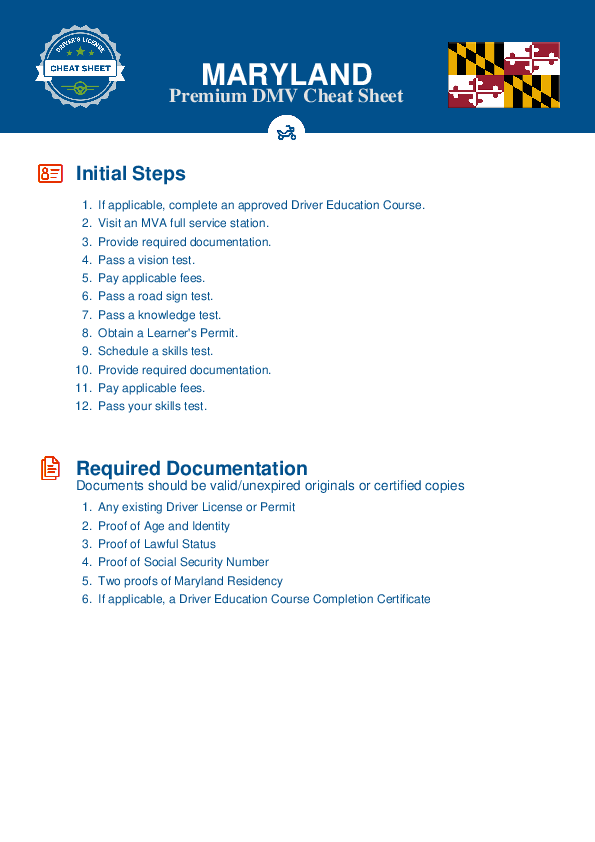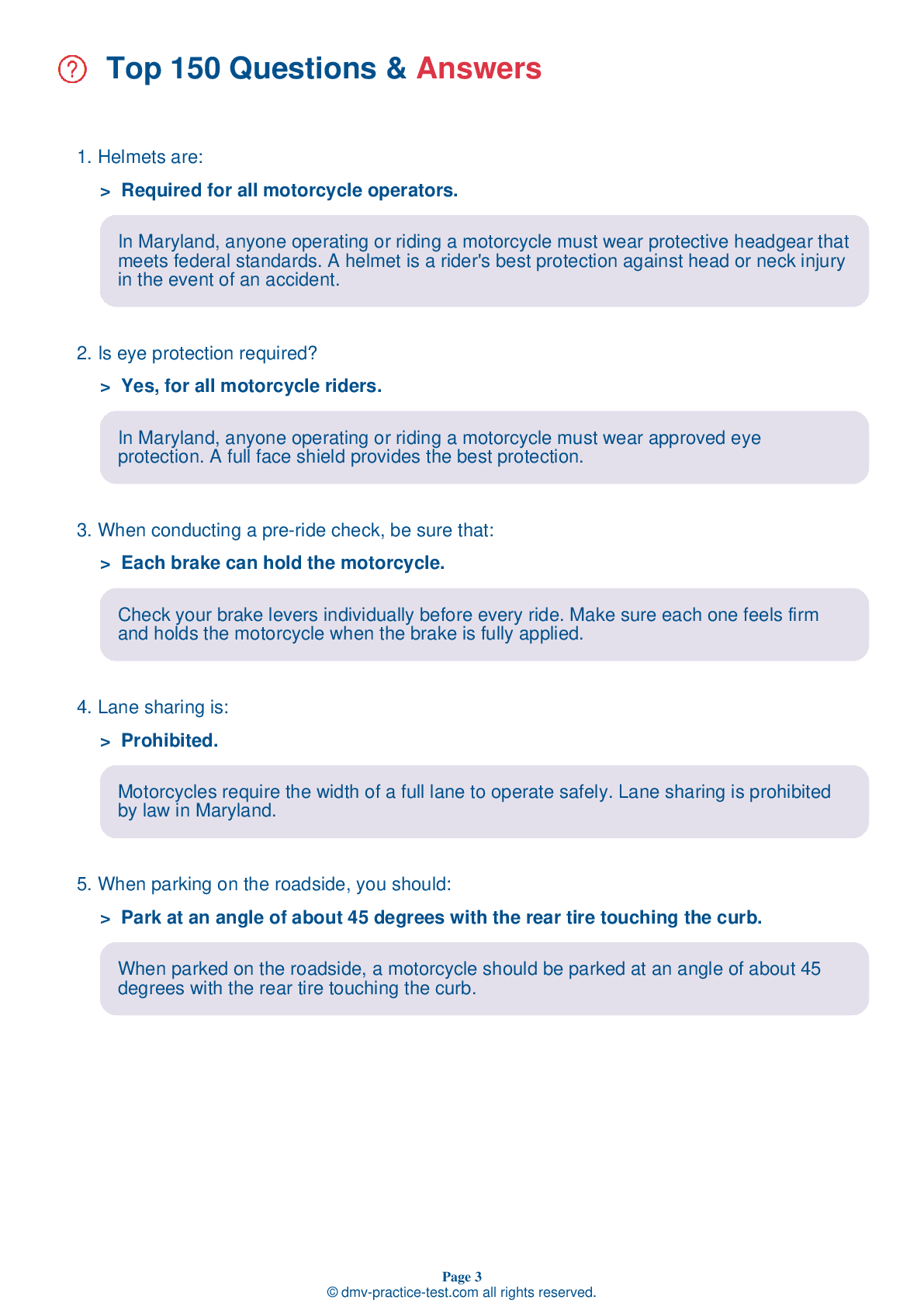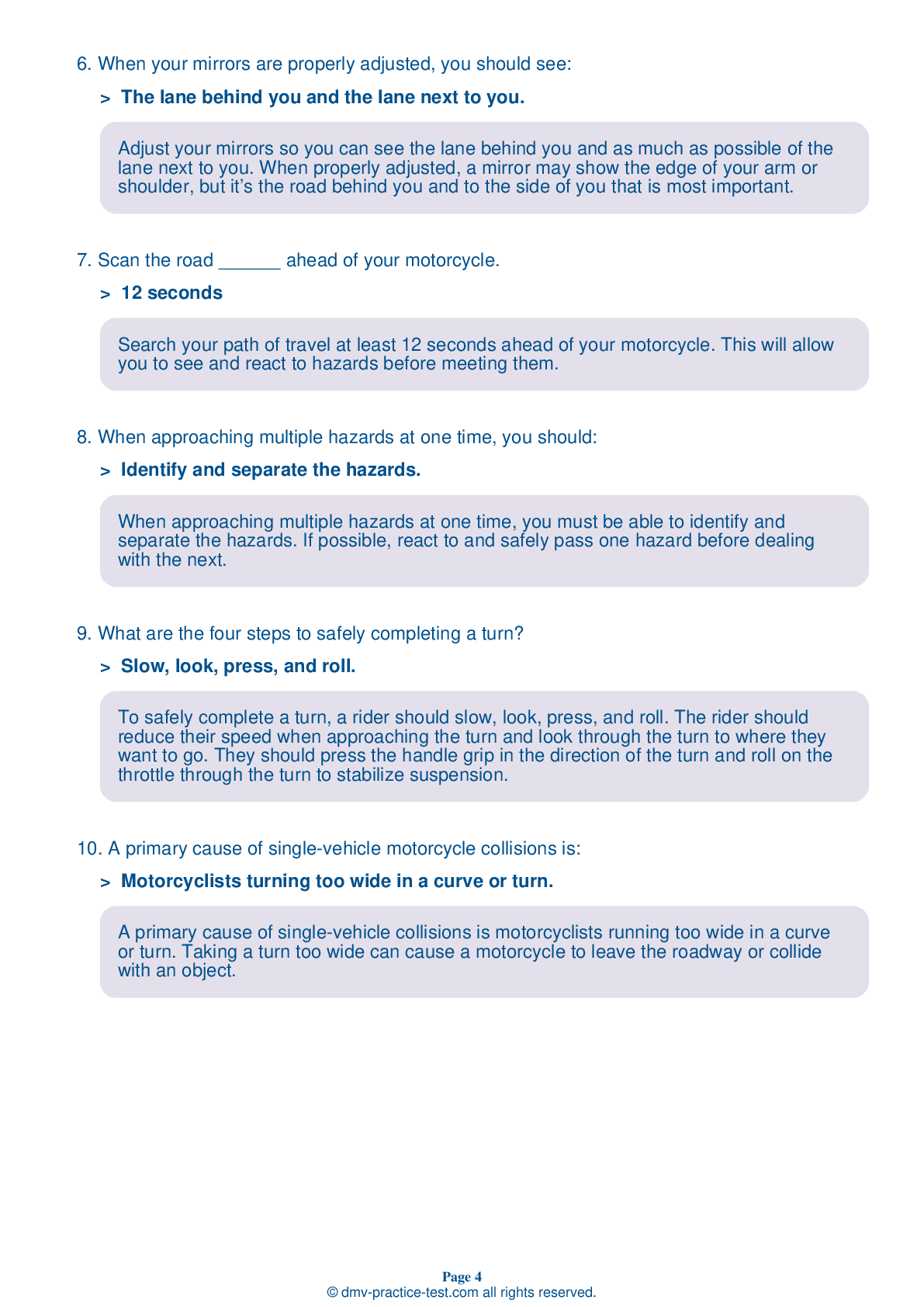DMV Permit Test #11
Motorcycle Test | License MD 2025 | FREE Online Practice! #11 Page 4 of 4
Take this FREE motorcycle test (license in MD 2025) to check your knowledge of the road rules. To improve your results, download a motorcycle handbook online, study theory, and practice for free on our website. Still worried about how to get a motorcycle license in Maryland in 2025? Check our website for more sample tests, train as much as possible, and boost your grades!
25
21
16
19 . Swerving a motorcycle:
Should be done to avoid a hazard on a slippery road.
Swerving is a quick maneuver that requires a lot of traction in order to be safely executed. Making sudden moves, such as swerving, on slippery surfaces should be avoided.
20 . Most crashes happen:
Several hours into the ride.
Most crashes happen on trips that are shorter than five miles, just a few minutes after the rider starts out.
21 . When being followed too closely by another vehicle, you should:
Exit the roadway.
The best way to deal with a tailgater is to get them ahead of you. If you can do so safely, change lanes and let them pass. Speeding up may only increase the danger by encouraging them to continue tailgating you at a higher speed.
22 . A plastic, shatter-resistant face shield protects the wearer from:
Sunshine.
In addition to protecting your face from injury in a crash, a face shield protects you from wind, dust, dirt, rain, insects, and pebbles thrown up from surrounding vehicles.
23 . MVA will suspend the license of any rider who:
Refuses to submit to a test to determine their blood alcohol concentration (BAC).
Any person who operates or attempts to operate a motor vehicle on a Maryland roadway consents to take a test determining the concentration of alcohol, or any other controlled dangerous substance, in their blood. Refusal to take such a test upon the request of an officer will result in license suspension.
24 . When riding at night, a motorcyclist should:
All of the above.
Riding at night can be dangerous because a rider’s ability to see and be seen by fellow motor vehicle operators is limited. It is recommended that riders adjust their riding behavior to compensate for this limited visibility by reducing their speed, maximizing their headlight usage, and increasing their following distance.
25 . A “No stopping” sign means that, unless directed to do so by a police officer, you may stop only:
For less than five minutes.
A "No stopping" sign means you can only stop to obey a traffic signal, to obey a police officer, or to prevent a conflict with another vehicle.
Need Motorcycle Insurance? No problem!
Compare the best rates in Maryland and find a personalized policy that meets your needs.
1. Are You Currently insured ?
2. Married ?
3. Do you own your Home?
4. Have you or a Family Member Honorably Served in U.S. Military ?
5. Your Name
6. Age
7. Zip code
Ranked by best match
2025 Maryland | Frequently Asked Questions
To acquire a motorcycle license in Maryland, you must first obtain a Class M motorcycle learner's permit by passing a vision test and knowledge test at a Maryland MVA office. After this, you must complete the Maryland Motorcycle Safety Program's Basic Rider Course. Upon successful completion, you can then apply for a full Class M license at the MVA.
In Maryland, the minimum age for obtaining a motorcycle driver's license is 16 years and 6 months. However, if you're under 18, you must complete the Maryland Motorcycle Safety Program's Basic Rider Course. Additionally, minors need to have their parent's or guardian's consent and should have held a learner's permit for at least 9 months.
Yes, in Maryland, you need a separate, specific license to operate a motorcycle, known as a motorcycle endorsement. This is in addition to a standard driver's license. It requires passing a written exam and a skills test. The process ensures that motorcycle riders have the necessary skills and knowledge for safe operation.
To apply for a motorcycle driver's license in Maryland, you'll need to provide proof of identity (like a birth certificate or passport), proof of Social Security (like a Social Security card or W-2 form), and two proofs of Maryland residency (like utility bills or bank statements). You'll also need to pass vision and knowledge tests, and complete a motorcycle safety course.
Yes, to obtain a motorcycle license in Maryland, you will need to pass a written exam. This exam tests your knowledge of motorcycle operation, traffic laws, and safe riding techniques. However, if you complete a Maryland Motorcycle Safety Program course, the written and skills test may be waived. Always check with the Maryland Motor Vehicle Administration for current requirements.
The written motorcycle test in Maryland covers a variety of subjects related to motorcycle safety and operation. These include traffic laws, road signs, safe riding techniques, handling dangerous situations, and the effects of alcohol and drugs on riding. The test is based on the information contained in the Maryland Motorcycle Operator Manual.
No, in Maryland, you cannot substitute the written test with a motorcycle training course. The training course can waive the skills test but not the written one. The written test is mandatory to ensure that you understand traffic laws, road signs, and safe riding techniques before you get your motorcycle license.
To enroll in a motorcycle training course in Maryland, first find a Motor Vehicle Administration (MVA) approved course provider. You can do this online or by calling the MVA. Once you've chosen a provider, contact them directly to enroll. Some providers allow online enrollment, while others may require you to call or visit in person. Fees and schedules vary by provider.
No, you don't have to own the motorcycle used for the license test in Maryland. The motorcycle can be borrowed but it must be registered, insured, and pass all safety standards. However, unless you have a valid motorcycle learner's permit, a licensed motorcycle operator must bring the bike to the test site.
Yes, you can use a friend's motorcycle for the Maryland motorcycle license test, provided it's registered, insured, and meets safety standards. However, you must have a valid motorcycle learner's permit or a licensed motorcycle operator must bring the bike to the test site for you. Always check with your local Motor Vehicle Administration office for specific rules.
Yes, in Maryland, the motorcycle driving exam tests specific handling skills. These include ability to start and stop, turn and swerve, quick stop, obstacle swerve, and cone weave. The test is designed to assess your ability to control the motorcycle under various circumstances, ensuring safety on the road.
Yes, in Maryland, new motorcycle drivers under the age of 18 are required to complete a Basic Rider Course. They also have a provisional license period, which includes restrictions like no passengers, no driving between midnight and 5 am, and zero alcohol tolerance. These restrictions are lifted after 18 months of clean driving record.
Yes, your Maryland motorcycle license is valid across the United States. It allows you to legally operate a motorcycle in all other states. However, you must observe the traffic laws of the state you are in, as they may differ from those in Maryland. Always check local regulations when traveling to unfamiliar areas.
Yes, it is mandatory to wear a helmet when operating a motorcycle in Maryland. According to Maryland's law, all motorcycle drivers and passengers are required to wear a helmet that meets the safety standards set by the U.S. Department of Transportation. Additionally, eye protection is required unless the motorcycle is equipped with a windscreen.
Yes, Maryland offers two types of motorcycle licenses: Class M and Class M with a J restriction. A Class M license allows you to operate any motorcycle. A Class M license with a J restriction is for mopeds and motor scooters only. The type of license you need depends on the type of motorcycle you intend to drive.
Yes, in Maryland, you can add supplementary endorsements to your motorcycle license. Endorsements allow for the operation of different types of vehicles such as motorcycles, school buses, and commercial vehicles. To add an endorsement, you typically need to pass both a written test and a skills test related to the specific type of vehicle.
Yes, it is possible to take the motorcycle license test in Maryland in various languages other than English. The Maryland Motor Vehicle Administration (MVA) offers the test in languages like Spanish, Korean, French, etc. However, you should contact your local MVA office beforehand to check the availability of your preferred language.
An effective strategy to prepare for the motorcycle license test in Maryland is to study the Maryland Motorcycle Operator Manual thoroughly. It covers all topics that will be on the test. Additionally, taking practice tests online can be beneficial as they simulate the actual exam environment, helping you understand the format and type of questions asked.
Yes, the motorcycle written test in Maryland can be taken in several languages other than English. The Maryland Motor Vehicle Administration (MVA) offers the test in Spanish, Korean, French, and more. However, it's recommended to contact your local MVA office ahead of time to confirm the availability of your preferred language.
If you don't pass the motorcycle written test in Maryland, you will be allowed to retake it. However, you must wait at least one day before your next attempt. If you fail the test three times, you'll be required to wait 7 days before retaking it. You must also pay a re-examination fee each time.



